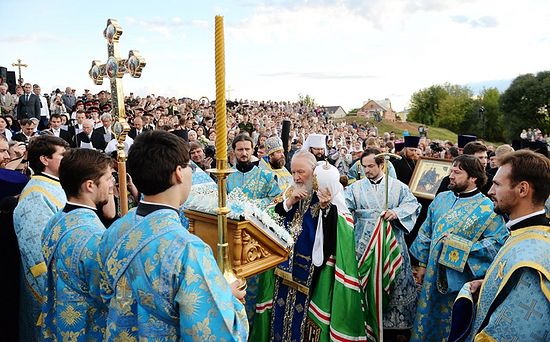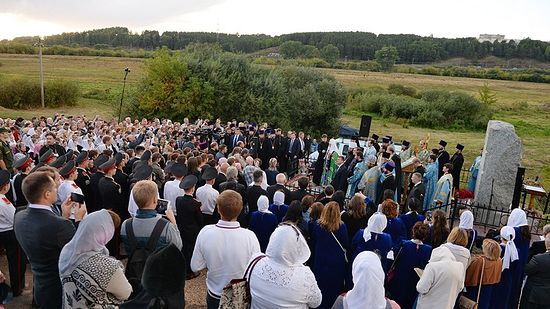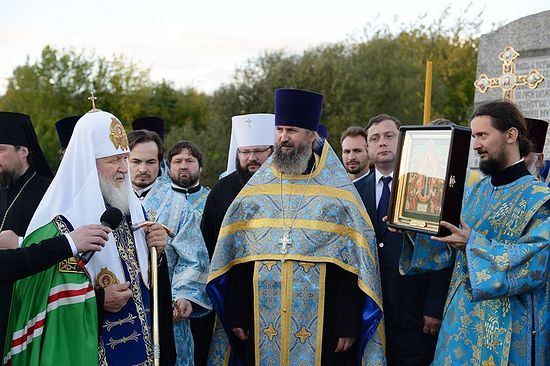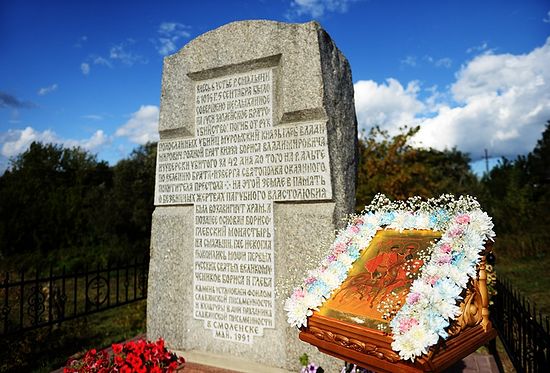Smolensk, August 30, 2015
In the evening of August 29, 2015, His Holiness Patriarch Kirill of Moscow and All Russia, after his visit to the St. Vladimir’s Monastery in the Sychevka district of the Russia’s Smolensk region at the mouth of the river Dnieper, arrived to the city of Smolensk, reports Patriarchia.ru.
Near the commemorative sign installed in the area called Smyadyn in the western part of Smolensk where, according to tradition, the Holy Prince Gleb, son of Holy Equal-to-the-Apostles Prince Vladimir, was killed in 1015, the primate of the Russian Orthodox Church performed a prayer service to the Holy Passion-Bearers Boris and Gleb.
Metropolitan Isidore of Smolensk, secretary of the administration of the Smolensk Diocese; Rector of the Church of Sts. Boris and Gleb in Smolensk Archpriest Pavel (Paul) Petrovsky, and clergy of the Diocese of Smolensk concelebrated with the Patriarch.
The hierarchical choir of the Smolensk Dormition Cathedral under direction of Elena Frolova and the choir of students of the inter-diocesan theological school of the Smolensk Diocese sang at the prayer service.
Acting Governor of the Smolensk region A.V. Ostrovsky, head of the city of Smolensk E.A. Pavlov, head of the administration of the city of Smolensk N.A. Alasheyev, professors and students of the Smolensk Theological Seminary and the Smolensk theological school, the military school of Smolensk, representatives of the government bodies and public organizations as well as Smolensk residents were present at the service.
After the prayer Patriarch Kirill delivered his archpastoral speech to those gathered at the event.
Head of the Russian Orthodox Church gave the Icon of the Mother of God, “Consolation of All Who Sorrow”, to the Church of Holy Martyrs Boris and Gleb in Smolensk. The faithful received small icons of the Holy Prince Vladimir, Equal-to-the-Apostles, with the patriarchal blessing.
* * *
The area (now suburb) of Smyadyn is first mentioned by the chronicle in 1015 in connection with the murder of Prince Gleb. When Prince Vladimir died in Kiev, his son Gleb, passing through Smolensk, stopped at the mouth of the Smyadyn river which flows into the Dnieper. There, by order by Prince Svyatopolk the Accursed, another son of Prince Vladimir, St. Gleb was slain.
A stone Church in honor of Sts. Boris and Gleb was erected here in the first half of the 12th century with a monastery built around it. According to tradition, construction of the monastery began near the well that had appeared on the site of uncovering of the incorrupt body of Prince Gleb. Other churches were built beside the monastery as well, of which only the Church of Holy Archangel Michael survives. However, during the Russian-Polish war early in the 17th century the Monastery of Sts. Boris and Gleb was destroyed and today only remains of the stone foundations of the monastery can be seen.
In 1991, with the blessing of Metropolitan Kirill of Smolensk and Kaliningrad, now the Patriarch of Moscow and All Russia, through the efforts of the Foundation for Slavonic Literature and Culture a commemorative sign was installed in Smyadyn consisting of a stone with a cross engraved on it and the text relating the story of martyrdom of the Holy Prince Gleb.
In autumn 2013 a Church in honor of the Holy Right-Believing Princes and Passion-Bearers Boris and Gleb was consecrated in Smyadyn.
With the support of “Orthodox Initiative” grants competition a “Ladya” (“Boat”) archaeological camp was organized on the site of the Monastery of Sts. Boris and Gleb in summer 2014. In cooperation with the Institute of Archaeology of the Russian Academy of Sciences (RAS), the scientists researched the landscape.
Archaeological research continued in 2015. Archaeological-architectural excavation of the St. Basil’s Church of the late 12th century in Smyadyn were among the main areas of work. The new information and details received as a result of the latest excavation works will help in the future restoration of the monastery.




